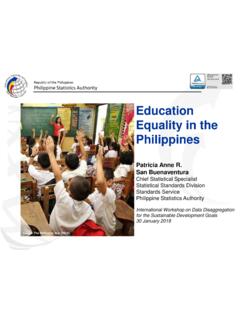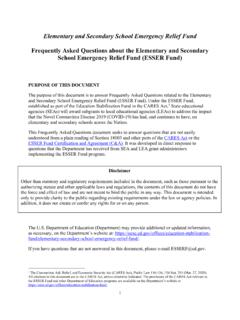Transcription of Unpacking Sustainable Development Goal 4 Education 2030
1 United Nations Sustainable Educational, Scienti c and Development Cultural Organization goals Unpacking Sustainable Development Goal 4. Education 2030. GUIDE. Khafizov Ivan Harisovich Unpacking Sustainable Development Goal 4. Education 2030. Guide Purpose This guide, organized around a set of questions and answers to unpack SDG4, provides overall guidance for a deeper understanding of SDG4 within the 2030 Agenda for Sustainable Development , in order to support its effective implementation. The guide outlines the key features of SDG4- Education 2030 and the global commitments expressed in the SDG4 targets as articulated in the Incheon Declaration and the Education 2030 Framework for Action.
2 The guide also examines the implications of translating these global commitments within, and through, national Education Development efforts. This guide has been prepared by the Section of Partnerships, Cooperation and Research, Division for Education 2030 Support and Coordination. 3. What is Education 2030. What is Education 2030? What is the 2030 Agenda for Sustainable Development ? The 2030 Agenda for Sustainable Development is an inter-governmental commitment and a plan of action for people, planet and prosperity . It comprises 17 Sustainable Development goals (SDGs) that are integrated and indivisible and balance the three dimensions of Sustainable Development : the economic, social and environmental ; and demonstrate the scale and ambition of the new universal They result from what is arguably the most inclusive process of consultation in the history of the United Nations, reflecting substantive input from all sectors of society, all actors of the international community and all parts of the world.
3 All Member States, the entire UN system, experts and a cross-section of civil society, business and, most importantly, millions of people from all corners of the globe, have committed themselves to this comprehensive agenda seeking to address globally-shared concerns and to promote the public good. How is Education articulated in the 2030 Agenda? Sustainable Development Goal 4: Education is central to the realization of the 2030 Agenda for Sustainable Development . Within the comprehensive 2030 Agenda for Sustainable Development , Education is essentially articulated as a stand-alone goal (SDG4) with its 7. outcome targets and 3 means of implementation.
4 Quality Education Ensure inclusive and equitable quality Education and promote lifelong learning opportunities for all Education -related targets across the SDGs: Education in the 2030 Agenda for Sustainable Development is not restricted to SDG4. Education , is specifically mentioned in targets of the five goals listed below, but also linked to almost all of the other SDGs in one way or another: Health and Well-being Target : By 2030, ensure universal access to sexual and reproductive health- care services, including for family planning, information and Education , and the integration of reproductive health into national strategies and programmes 1 United Nations A/RES/70/1 (Distr.)
5 : General 21 October 2015) Resolution adopted by the General Assembly on 25 September 2015 [without reference to a Main Committee (A/70 )] 70/1. Transforming our world: the 2030. Agenda for Sustainable Development 7. Unpacking Sustainable Development Goal 4 - Education 2030. Gender Equality Target : Number of countries with laws and regulations that guarantee women aged 15-49 years access to sexual and reproductive health care, information and Education Decent Work and Economic Growth Target : By 2020 substantially reduce the proportion of youth not in employment, Education or training Responsible Consumption & Production Target : By 2030 ensure that people everywhere have the relevant information and awareness for Sustainable Development and lifestyles in harmony with nature Climate Change Mitigation Target.
6 Improve Education , awareness raising and human and institutional capacity on climate change mitigation, adaptation, impact reduction, and early warning What are the underlying principles? 1. Education is a fundamental human right and an enabling right. To fulfil this right, countries must ensure universal access to inclusive and equitable quality Education and learning, leaving no one behind. Education shall aim at the full Development of the human personality and promote mutual understanding, tolerance, friendship and peace. 2. Education is a public good. The state is the main duty-bearer in protecting, respecting, and fulfilling the right to Education .
7 As a shared societal endeavour, Education implies an inclusive process of public policy formulation and implementation2. Civil society, teachers and educators, the private sector, communities, families, youth and children all have important roles in realizing the right to quality Education . The role of the state is essential in setting and regulating standards and norms. 3. Gender equality is inextricably linked to the right to Education for all. Achieving gender equality requires a rights-based approach that ensures that girls and boys, women and men not only gain access to and complete Education cycles, but are empowered equally in and through Education .
8 2 UNESCO (2015) Rethinking Education : Towards a common global good? 8. What is Education 2030. How does SDG4 differ from the MDGs and from EFA? As a global Education agenda, SDG4 differs from both the Education -related Millenium Develpment Goal (MDGs) and from Education For All (EFA) in scope, geographical coverage and policy focus. Table 1 below highlights some of these differences. Scope: While MDG2 was focused on children and access to primary Education , EFA had a broader agenda aimed at meeting the basic learning needs of children, youth and adults'. As we know, the EFA commitment to ensure the right to basic Education for all was not achieved by the deadline set for 2015.
9 SDG4 therefore pursues this unfinished Education agenda, but also goes beyond, committing all countries to ensure equal opportunity in access to quality learning opportunities at all levels of Education in a lifelong perspective. Geographical coverage: With its narrower scope on ensuring children's access to, and completion of primary Education , the geographical coverage of the MDGs was focused on low-income and conflict-affected countries in the South. This was not the case for EFA. While originally intended as a universal agenda to ensure quality basic Education for all in all countries across the world, in practice, EFA became focused on countries where the proportion of children out-of-school was the greatest.
10 SDG4, on the other hand, is, by definition a universal agenda applicable to all countries both in the global North, as well as the global South. Policy focus: From the narrower MDG focus on access to, and completion of, primary Education , EFA was concerned with access to quality basic Education for all children, youth and adults. This included early childhood care and Education , primary and secondary Education , as well as youth and adult literacy and life skills. SDG4 continues the EFA focus on quality basic Education for all and broadens the agenda further to include concern for equitable access to post-basic Education and training for youth and adults through equitable access to appropriate learning opportunities.


